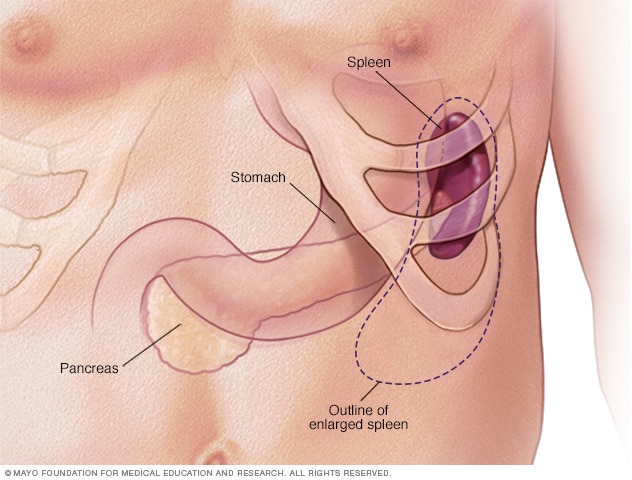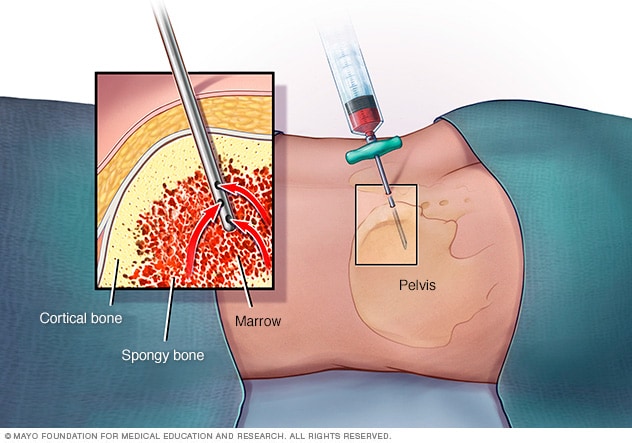Diagnosis
Enlarged spleen

Enlarged spleen
The spleen is a small organ usually about the size of your fist. But a number of conditions, including liver disease and some cancers, can cause your spleen to become enlarged.
Bone marrow exam

Bone marrow exam
In a bone marrow aspiration, a health care provider uses a thin needle to remove a small amount of liquid bone marrow, usually from a spot in the back of your hipbone (pelvis). A bone marrow biopsy is often done at the same time. This second procedure removes a small piece of bone tissue and the enclosed marrow.
To diagnose hairy cell leukemia, your health care provider may recommend:
- Physical exam. Your provider may feel your spleen to see if it's too big. The spleen is an oval-shaped organ on the left side of the upper abdomen. If your spleen is too big you might feel a fullness in your belly. You might have pain or discomfort when you eat.
-
Blood tests. You might have a blood test to measure the levels of blood cells in your blood. This test is called a complete blood count (CBC) with differential.
You have three main types of blood cells in your blood. They include red blood cells, white blood cells and platelets. In hairy cell leukemia, a CBC test may show all levels of these cells are too low.
Another type of blood test might involve looking at your blood under the microscope. This test can find hairy cell leukemia cells. This test is called a peripheral blood smear.
- Bone marrow biopsy. A bone marrow biopsy is a procedure to remove some of your bone marrow for testing. Your provider will remove a small amount of bone marrow from your hip area. This sample is used to look for hairy cell leukemia cells.
- Lab tests to analyze the leukemia cells. Hairy cell leukemia cells collected from your blood and bone marrow are tested in a lab. These tests look at the changes in the cells' DNA. This helps your provider understand your prognosis and what treatments are best for you.
- Computerized tomography (CT) scan. A CT scan shows detailed images of the inside of your body. Your provider may order a CT scan to look for swelling in your spleen and your lymph nodes.
Treatment
Hairy cell leukemia treatments are good at controlling the disease. But they can't make it go away completely. Instead, treatments can control the cancer so that you can go about your life as usual. People with hairy cell leukemia can live with the disease for many years.
Treatment might not need to start right away
Treatment for hairy cell leukemia doesn't always need to start right away. This cancer often gets worse very slowly over time. You might choose to wait and have treatment if the cancer starts to cause symptoms.
If you don't have treatment, you'll have regular appointments with your health care provider. You might have blood tests to see if hairy cell leukemia is getting worse.
You might decide to start treatment if you start to get hairy cell leukemia symptoms. Most people with hairy cell leukemia will eventually need treatment.
Chemotherapy
Chemotherapy is a drug treatment that uses powerful drugs to kill cancer cells. It's often the first treatment for hairy cell leukemia. Chemotherapy is very effective for hairy cell leukemia. Most people get a complete or partial remission after chemotherapy. Remission means you have no signs of cancer.
Chemotherapy for hairy cell leukemia can be given as a shot. Or it can be given as an infusion into a vein.
If your hairy cell leukemia comes back, your provider might recommend repeating chemotherapy with the same drug or trying a different drug. Another option may be targeted drug therapy.
Targeted drug therapy
Targeted drug treatments attack specific chemicals present within cancer cells. By blocking these chemicals, targeted drug treatments can cause cancer cells to die.
Targeted drug therapy is sometimes used as a first treatment for hairy cell leukemia. It can be used with chemotherapy. More often, targeted therapy is an option if the cancer comes back after chemotherapy.
Your health care provider will have your cancer cells tested to see whether targeted drug therapy is likely to work for you.
Clinical trials
Explore Mayo Clinic studies testing new treatments, interventions and tests as a means to prevent, detect, treat or manage this condition.
Alternative medicine
No alternative medicines are helpful for treating hairy cell leukemia. Alternative medicine might be helpful in other ways. It may help you cope with the stress of a cancer diagnosis and the treatment side effects.
Talk to your health care provider about your options, such as:
- Art therapy
- Exercise
- Meditation
- Music therapy
- Relaxation exercises
- Spirituality
Coping and support
A cancer diagnosis can feel overwhelming. To help you cope, you might consider trying to:
- Find out enough to feel comfortable making decisions about your care. Learn about hairy cell leukemia and cancer treatments. This can help you feel more confident about making decisions about your treatment. Ask your health care provider to suggest some reliable sources of information to get you started.
-
Connect with other cancer survivors. Friends and family provide an important support network during your cancer experience. But they can't always understand what it's like to face cancer. Other cancer survivors provide a unique network of support.
Ask your provider about support groups or organizations in your community that can connect you with other cancer survivors. Organizations such as the Hairy Cell Leukemia Foundation and the Leukemia & Lymphoma Society offer ways to connect with others online.
-
Take care of yourself. You can't control whether your hairy cell leukemia comes back, but you can control other aspects of your health.
Take care of yourself by eating a balanced diet with plenty of fruits and vegetables. Exercise regularly. Get enough sleep so that you wake up feeling refreshed. Find healthy ways to cope with the stresses in your life.
Preparing for your appointment
Start by seeing your usual health care provider if you have any symptoms that worry you. If your provider suspects you may have hairy cell leukemia, they may suggest that you see a specialist. This might be a doctor who treats diseases of the blood and bone marrow. This doctor is called a hematologist.
Appointments can be brief, so it's a good idea to be prepared. Here's some information to help you get ready.
What you can do
- Be aware of any pre-appointment restrictions. At the time you make the appointment, be sure to ask if there's anything you need to do in advance. For example, you might need to restrict your diet.
- Write down any symptoms you're experiencing, including any that may seem unrelated to the reason for which you scheduled the appointment.
- Write down key personal information, including any major stresses or recent life changes.
- Make a list of all medications, vitamins or supplements that you're taking.
- Consider taking a family member or friend along. Sometimes it can be hard to remember all the information provided during an appointment. Someone who comes with you may remember something that you missed or forgot.
- Write down questions to ask your doctor.
Your time with your provider is limited. Prepare a list of questions so that you can make the most of your time together. List your questions from most important to least important in case time runs out. For hairy cell leukemia, some basic questions to ask include the following:
- What kinds of tests do I need?
- Will I need treatment for my hairy cell leukemia?
- If I don't have treatment, will my leukemia worsen?
- If I need treatment, what are my options?
- Will treatment cure my hairy cell leukemia?
- What are the side effects of each treatment option?
- Is there one treatment you feel is best for me?
- How will cancer treatment affect my daily life?
- I have these other health conditions. How can I best manage them together?
- Are there any restrictions that I need to follow?
- Should I see a specialist? What will that cost, and will my insurance cover it?
- Are there brochures or other printed material that I can take with me? What websites do you suggest?
What to expect from your doctor
Your provider is likely to ask you a number of questions. Being ready to answer them may allow more time later to cover other points you want to address. Your provider may ask:
- When did you begin having symptoms?
- Have your symptoms been continuous or occasional?
- How severe are your symptoms?
- What, if anything, seems to improve your symptoms?
- What, if anything, makes your symptoms worse?